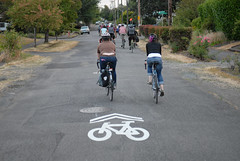
of pavement maintenance, but current
methods — developed for major arterials — are
cost-prohibitive.
(Photo © J. Maus)
The City of Portland is working hard to make the growing network of “next generation” bike boulevards (a.k.a. neighborhood greenway) streets as comfortable for people on bikes as possible. They’ve turned stop signs to make them more efficient and safer, they’ve added sharrows and wayfinding signs, they’ve added speed bumps to calm motor vehicle traffic, and they’ve added medians and other elements to make crossings safer and easier.
But there’s one major thing that PBOT hasn’t been able to do in their bike boulevard program — smooth out potholes, bumps, and cracks in old pavement. Re-paving is very expensive and the current City budget has focused all paving and maintenance resources onto major arterials. That leaves many of Portland’s local streets — the ones where bike boulevards are being built — in disrepair.
Poor pavement quality has a big impact on bicycling and it’s an issue that was raised repeatedly by residents at PBOT’s bike boulevard meetings. At one such meeting, after someone wondered why re-paving wasn’t in the plans, a PBOT staffer replied in jest (and I paraphrase), “We can either bring you this entire bike boulevard project [which people in the meeting were cheering for a few minutes prior], or we can repave one block.”
“There is a hope that this work can achieve real saving over routine maintenance designed for higher volume streets carrying heavier vehicles.”
— Mark Lear, PBOT
But now PBOT is considering a solution to this problem that might result in smoother bike boulevards by next spring. PBOT project manager Kyle Chisek confirms that this winter they’ll be working to develop a new process that will result in a more cost-effective way to smooth out local streets.
PBOT’s traffic safety manager Mark Lear, the agency’s lead staffer on the bike boulevard program, says, “This winter PBOT will be developing cost effective maintenance strategies for our neighborhood greenway projects.” It’s unclear what exactly they plan to do, but PBOT has already identified street sections that will be used to develop the process:
- NE Going from 33rd to 35th
- N Bryant from Oatman to Villard
- SW Vermont from 30th to 33rd
- SE Bush at 136th
The development of this process could reap huge benefits for local streets. It would allow PBOT to officially recognize the vast difference in maintenance and paving needs between major arterials with heavy truck and car traffic and bike boulevard streets where most of the vehicles are bicycles (or, at least that’s the goal).
Or, in the words of Lear, “There is a hope that this work can achieve real saving over routine maintenance designed for higher volume streets carrying heavier vehicles.” PBOT project manager Dan Layden says the idea behind the new process would be to “… go in and repair the local street enough so that there’s a good surface for bikes without completely rebuilding the street.” On a recent ride with the City’s Bike Advisory Committee, Lear mentioned that one possibility might be to add a strip of smooth pavement to a street about the width of a bike lane.
Better pavement quality on bike streets would make them more attractive, efficient, and safer — all of which are key to bringing out the families, kids, and “interested but concerned” crowd PBOT is so actively courting.
— See all our bike boulevard coverage here.

